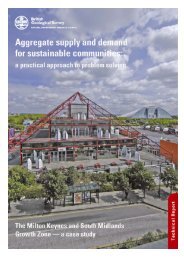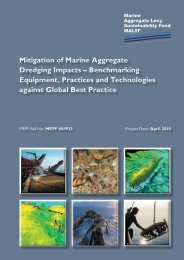creating environmental improvements through biodiversity
creating environmental improvements through biodiversity
creating environmental improvements through biodiversity
Create successful ePaper yourself
Turn your PDF publications into a flip-book with our unique Google optimized e-Paper software.
free of charge to key stakeholders. Marketing will be carried out <strong>through</strong> a mailing list to the target audience,<br />
and adverts will be taken out in industry, local government and planning publications. Further promotion will be<br />
achieved <strong>through</strong> a one page leaflet and a press pack. Additional copies will be available to the public and others<br />
<strong>through</strong> Buglife.<br />
A feedback process will help to ensure that the intended users of the Guide have the opportunity to comment<br />
on a draft. There will also be an opportunity for end users to provide constructive feedback on the Guide once<br />
it has been published.<br />
DEVELOPING POLICY AND BEST PRACTICE IN RELATION TO<br />
RESTORATION FOLLOWING MINERALS EXTRACTION – RESOLVING<br />
CONFLICTS WITH AVIATION<br />
(MIRO, ODPM, DCLG - CSL, RSPB)<br />
Analysis of Waterbody Characteristics and Bird Populations Andrew Robinson, Carola Deppe<br />
(Central Science Laboratory)<br />
March 2004<br />
Sustainable Aggregates Creating Environmental Improvements <strong>through</strong> Biodiversity<br />
Project Type: GIS analysis<br />
Site: numerous sites <strong>through</strong>out Great Britain<br />
Project Aim:<br />
To attempt to discover if relationships (identified on some sites in the previous two reports) could be found<br />
between the physical and botanical characteristics of lakes and the numbers of waterfowl using them, in a<br />
larger sample of former mineral extraction sites<br />
To attempt to discover key morphological characteristics of water bodies that could be used to predict bird<br />
numbers<br />
Main Methods:<br />
Analysis of simple relationships between water body size and shape (on former mineral extraction sites), and<br />
types of bird using the habitat<br />
Data on mineral extraction sites from British Geological Survey (BGS) combined onto a map with counts<br />
from the Wetland Bird Survey (WeBS), using ArcView GIS<br />
WeBS data divided and dealt with in two separate databases - summer and winter<br />
Digital mapping of individual lakes to assemble data on lake area, perimeter length, and number of islands<br />
Correlation of lake characteristics with total numbers of waterfowl, and total numbers of different waterfowl<br />
guilds (swans, geese, dabbling duck, diving duck, sawbills), to assess determining factors<br />
Principle components analysis used to further test results<br />
Regression analysis of likely total number of waterfowl to be found on a given pit<br />
Main Methods:<br />
Analysis of simple relationships between water body size and shape (on former mineral extraction sites), and<br />
types of bird using the habitat<br />
Data on mineral extraction sites from British Geological Survey (BGS) combined onto a map with counts<br />
from the Wetland Bird Survey (WeBS), using ArcView GIS<br />
WeBS data divided and dealt with in two separate databases - summer and winter<br />
Digital mapping of individual lakes to assemble data on lake area, perimeter length, and number of islands<br />
Correlation of lake characteristics with total numbers of waterfowl, and total numbers of different waterfowl<br />
81

















